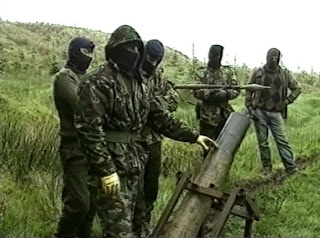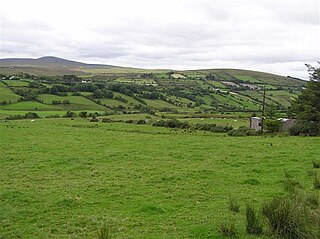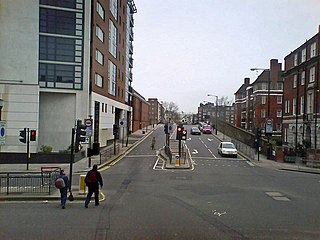Barracks bombing
On 7 October 1996, two Provisional IRA volunteers gained access to the base using forged passes based on the identity card of a former British soldier who had joined the IRA. [5] [6] They drove two 800-pound (360 kg) [7] car bombs several hundred yards into the Thiepval Barracks in Lisburn, which housed the British Army headquarters in Northern Ireland. [8] The first car bomb detonated near a travel arrangement centre, injuring many people. When the wounded were moved to the military medical centre, the second car bomb detonated there, catching the victims of the first blast as well as the medical staff helping them. The medical centre was reduced to rubble. [9] There was a lapse of 12 minutes between the first and the second blast. [10] There were 31 injured, four of them seriously. A British soldier, Warrant Officer James Bradwell, died four days later of multiple wounds. [11] He was the first soldier to be killed in Northern Ireland since 1994. [12]
The attack coincided with the beginning of the Conservative Party conference in Bournemouth and a meeting between loyalist prisoners and members of the Progressive Unionist Party (PUP) in the Maze prison. [11] The IRA claimed responsibility on 8 October, in a telephone call to RTÉ news in Dublin. [7] The IRA statement said the target had been barracks personnel and said injuries to civilians were regretted. [7] According to one source, the main security failure that allowed the IRA to penetrate the base was the external security checkpoints and cameras. [13] At first, the RUC's main suspect was a man in his 40s "with a black beard, dark hair and blackrimmed glasses", although investigators thought it was a disguise. [14] A north Belfast man was eventually charged for the bombing on 1 November 1996. [15]
Aftermath
Sinn Féin leader Gerry Adams was reluctant to confirm whether or not the IRA was involved, and vowed for talks with the British government and the unionist parties. He warned however that "There has been a protracted political vacuum here. If we don't fill that vacuum with real talks then it will be filled with the sort of serious incidents we saw yesterday". [7]
John Bruton, then Taoiseach of the Republic of Ireland, called the bombing a "cynical betrayal of the peace process" by the IRA, [14] while PUP leader David Ervine appealed to loyalists not to seek retaliation for the bombing. [7] John Major, the British prime minister, made clear that "the IRA would not bomb its way into the Stormont talks". [11]
The attack was seen as a confirmation that the IRA had given up any hope of achieving a political breakthrough until the next British general elections in 1997. [7]
The Real Irish Republican Army, or Real IRA (RIRA), was a dissident Irish republican paramilitary group that aimed to bring about a United Ireland. It was formed in 1997 following a split in the Provisional IRA by dissident members, who rejected the IRA's ceasefire that year. Like the Provisional IRA before it, the Real IRA saw itself as the only rightful successor to the original Irish Republican Army and styled itself as simply "the Irish Republican Army" in English or Óglaigh na hÉireann in Irish. It was an illegal organisation in the Republic of Ireland and designated a proscribed terrorist organisation in the United Kingdom and the United States.
Bloody Friday is the name given to the bombings by the Provisional Irish Republican Army (IRA) in Belfast, Northern Ireland on 21 July 1972, during the Troubles. At least twenty bombs exploded in the space of eighty minutes, most within a half-hour period. Most of them were car bombs and most targeted infrastructure, especially the transport network. Nine people were killed: five civilians, two British soldiers, a Royal Ulster Constabulary (RUC) reservist, and an Ulster Defence Association (UDA) member, while 130 were injured. The IRA said it sent telephoned warnings at least thirty minutes before each explosion and said that the security forces wilfully ignored some of the warnings for their own ends. The security forces said that was not the case and said they were overstretched by the sheer number of bombs and bomb warnings, some of which were hoaxes.

Thiepval Barracks is a British Army barracks and headquarters in Lisburn, County Antrim.

Ulster loyalism is a strand of Ulster unionism associated with working class Ulster Protestants in Northern Ireland. Like other unionists, loyalists support the continued existence of Northern Ireland within the United Kingdom, and oppose a united Ireland independent of the UK. Unlike other strands of unionism, loyalism has been described as an ethnic nationalism of Ulster Protestants and "a variation of British nationalism". Loyalists are often said to have a conditional loyalty to the British state so long as it defends their interests. They see themselves as loyal primarily to the Protestant British monarchy rather than to British governments and institutions, while Garret FitzGerald argued they are loyal to 'Ulster' over 'the Union'. A small minority of loyalists have called for an independent Ulster Protestant state, believing they cannot rely on British governments to support them. The term 'loyalism' is usually associated with paramilitarism.

From 1969 until 1997, the Provisional Irish Republican Army (IRA) conducted an armed paramilitary campaign primarily in Northern Ireland and England, aimed at ending British rule in Northern Ireland in order to create a united Ireland.

The Shankill Road bombing was carried out by the Provisional Irish Republican Army (IRA) on 23 October 1993 and is one of the most well-known incidents of the Troubles in Northern Ireland. The IRA aimed to assassinate the leadership of the loyalist Ulster Defence Association (UDA), supposedly attending a meeting above Frizzell's fish shop on the Shankill Road, Belfast. Two IRA members disguised as deliverymen entered the shop carrying a bomb, which detonated prematurely. Ten people were killed: one of the IRA bombers, a UDA member and eight Protestant civilians, two of whom were children. More than fifty people were wounded. The targeted office was empty at the time of the bombing, but the IRA had allegedly realised that the tightly packed area below would inevitably cause "collateral damage" of civilian casualties and continued regardless. However, the IRA have denied this saying that they intended to evacuate the civilians before the explosion. It is alleged, and unearthed MI5 documents appear to prove, that British intelligence failed to act on a tip off about the bombing.
The Troubles in Lisburn recounts incidents during, and the effects of, the Troubles in Lisburn, County Antrim, Northern Ireland.

The London Docklands bombing occurred on 9 February 1996, when the Provisional Irish Republican Army (IRA) detonated a powerful truck bomb in South Quay. The blast killed two people and devastated a wide area, causing an estimated £150 million worth of damage. The IRA had sent warnings 90 minutes beforehand, but the area was not fully evacuated. As well as the two people who were killed, more than 100 were injured, some permanently.
Events during the year 1996 in Northern Ireland.
The Ballygawley bus bombing was a roadside bomb attack by the Provisional Irish Republican Army (IRA) on a bus carrying British soldiers in Northern Ireland. It occurred in the early hours of 20 August 1988 in the townland of Curr near Ballygawley, County Tyrone. The attack killed eight soldiers and wounded another 28. In the wake of the bombing, the British Army began ferrying its troops in and out of County Tyrone by helicopter.
This is a chronology of activities by the Provisional Irish Republican Army (IRA) from 1980 to 1989. For actions before and after this period see Chronology of Provisional Irish Republican Army actions.
This is a chronology of activities by the Provisional Irish Republican Army (IRA), from 1992 to 1999.

The Osnabrück mortar attack was an improvised mortar attack carried out by a Provisional Irish Republican Army (IRA) unit based in mainland Europe on 28 June 1996 against the British Army's Quebec Barracks at Osnabrück Garrison near Osnabrück, Germany.

The Teebane bombing took place on 17 January 1992 at a rural crossroads between Omagh and Cookstown in County Tyrone, Northern Ireland. A roadside bomb destroyed a van carrying 14 construction workers who had been repairing a British Army base in Omagh. Eight of the men were killed and the rest were wounded. Most were civilians, while one of those killed and two of the wounded were off-duty British soldiers. The Provisional Irish Republican Army (IRA) claimed responsibility, saying the workers were targeted because they were collaborating with the "forces of occupation".

On 15 June 1988 an unmarked military van carrying six British Army soldiers was blown up by the Provisional Irish Republican Army (IRA) at Market Place in Lisburn, Northern Ireland. The explosion took place at the end of a charity marathon run in which the soldiers had participated. All six soldiers were killed in the attack – four outright, one on his way to hospital and another later on in hospital.
The Hillcrest Bar bombing, also known as the "Saint Patrick's Day bombing", took place on 17 March 1976 in Dungannon, County Tyrone, Northern Ireland. The Ulster Volunteer Force (UVF), a loyalist paramilitary group, detonated a car bomb outside a pub crowded with people celebrating Saint Patrick's Day. Four Catholic civilians were killed by the blast—including two 13-year-old boys standing outside—and almost 50 people were injured, some severely.

The Chelsea Barracks bombing was an attack carried out by a London-based Active Service Unit (ASU) of the Provisional IRA on 10 October 1981, using a remote-controlled nail bomb. The bomb targeted a bus carrying British Army soldiers just outside Chelsea Barracks. The blast killed two civilians and injured 40 people, among them 23 soldiers.
This is a timeline of the events and actions during the Troubles that were carried out in Great Britain, the vast majority of which were carried out by Irish Republican paramilitaries mainly the Provisional IRA were by far the most active but both the Official IRA and the Irish National Liberation Army, also carried out a number of attacks, which included bombings and shootings. Ulster Loyalist paramilitary groups also carried out a small number of violent actions.
This is a chronology of activities by the Provisional Irish Republican Army (IRA), in 1990 and 1991.









